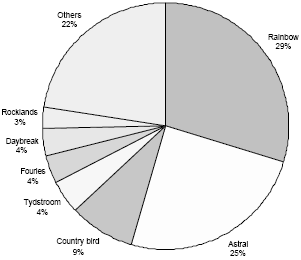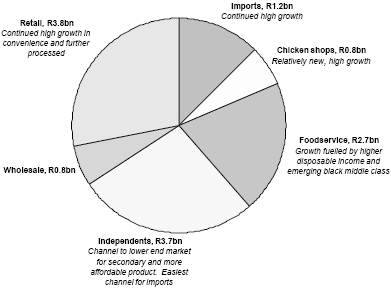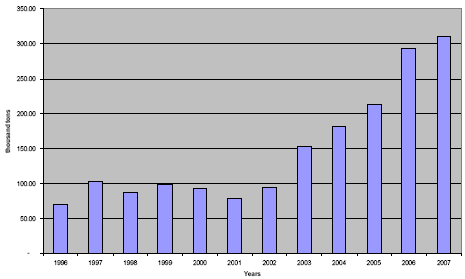



South Africa Poultry and Products Annual 2007
By the USDA, Foreign Agricultural Service - This article provides the poultry industry data from the USDA FAS Poultry and Products Annual 2007 report for South Africa. A link to the full report is also provided. The full report includes all the tabular data which we have ommited from this article.Report Highlights
Poultry production, especially broiler production, is becoming big business in South Africa. The South African poultry industry now accounts for an estimated 16% of the total gross value of primary agriculture. Domestic demand for poultry meat is growing in the region of 7% per annum, which outstrips the performance of any other protein on the market. Imports of poultry meat are on the increase primarily from Brazil. United States poultry exports to South Africa are restricted by an anti-dumping duty in place since 2000. While the demand side factors in the poultry market are promising, the bulk of the risks for industry players – and investors – lie on the supply side. These risks include corn price increases, diseases, theft and price wars. Nonetheless, the industry is confident in the longterm opportunities and is increasing capital expenditures which will increase poultry production by 10% over the next two years.
Executive Summary
South Africa’s poultry market is estimated to have grown by 11% to R13.5bn (US$2.1bn) for the financial year to 31 March 2007, contributing approximately 16% of the total gross value of primary agriculture in South Africa. Driven by demand factors, poultry production is becoming big business in South Africa. The broiler industry in South Africa currently produces on average 13.8 million broilers per week. Producers have announced sizeable capital expenditure programs to upgrade output volumes. These expansion plans flow from a realization amongst producers that there is a long-term structural change in chicken consumption patterns. The expansions will increase chicken supplies by more than 10% or by 1.5 million broilers per week over the next two years.Domestic demand for poultry meat is growing by about 7% per annum, which outstrips the performance of any other proteins on the market. The steady growth of South Africa’s economy is the main overall driver for the increased demand for poultry meat. Rising living standards are pushing increasingly more consumers towards protein-filled diets, health awareness and convenience. South Africans now eat more than double as much poultry as in the 1970’s. Expectations are that this growth in poultry meat consumption will continue.
Imports increased substantially over the past few years and amounted to R1.2 billion or 293 thousand tons in 2006. Expectations are that imports will increase to more than 300 thousand tons in 2007. Imports represent approximately 10% of the total value of the poultry market in South Africa or more than 20% of production. Brazil is the most important trading partner for South Africa in terms of poultry meat, having more than 70% of the import market. United States poultry exports to South Africa are constrained by an antidumping duty.
US$1 = Rand 6.46 (11/09/07)
Production
It is estimated that the poultry industry contributes approximately 16% of the total gross value of agriculture in South Africa. The broiler industry in South Africa currently produces on average 13.8 million broilers per week, growing steadily from 1990 when only 7.6 million broilers per week were produced. While the demand side factors in the poultry market are promising, the bulk of the risks for industry players – and investors – lie on the supply side. These risks include corn price rises, imports, diseases, theft and price wars. Though mindful of the risk, producers have announced sizeable capital expenditure programs to upgrade output volumes. These expansion plans flow from a realization amongst producers that there is a long-term structural change in chicken consumption patterns. The expansions will increase chicken supplies by more than 10% over the next two years. This will, however, probably be just enough to keep up with existing demand levels. |
| Figure 1: Average broiler production volumes per week |
The broiler industry in South Africa is dominated by 2 large producers, namely Rainbow and Astral. Together, these two companies produce 55% of total broiler production in South Africa. Rainbow, on average, produces 4.1 million broilers per week and Astral, on average, 3.4 million broilers per week. The third largest producer, Country Bird, produces 1.2 million broilers per week or 9% of total broiler production in South Africa. 4 medium-sized producers (producing more than 400 000 broilers per week) supply 15% of the market followed by approximately 50 smaller producers (producing less than 200 000 broilers per week). A degree of consolidation has taken place in recent years, with bigger players buying up some of the smaller producers. In addition to producing economies of scale, these actions have reduced the potential for price wars in the consumer market. As a result, chicken meat prices increased by about 6% per annum between 2001 and 2006.
 |
| Figure 2: The major producers in the boiler industry of South Africa |
As corn is the major ingredient (more than 50%) in broiler feed, any changes in the price of corn impact directly on the profit margin of broiler producers. The broiler industry uses approximately 2.5 million tons of feed annually, which represents 30% of all feed manufactured in South Africa. With the expectation for corn and soya prices to remain at current high levels, the feed input cost will be significantly higher in coming years, thereby putting pressure on profit ma rgins (see SF7040 for an update on the corn situation in South Africa).
Another production factor that increases the risk of investing in the industry is potential outbreak of diseases such as Avian Flu and Newcastle. To date, the Avian Influenza epidemic has not impacted South African poultry industry. The South African poultry industry, however, has formulated an action plan for immediate implementation in the event of an outbreak of “bird flu”. This action plan includes government, producers, consume rs, trade and media campaigns.
Improved animal husbandry, stricter disease control and production efficiencies have contributed to lower chicken mortality rates in the industry over the past three to four years. Foreign as well as local authorities ensure high sanitary standards in the South African poultry production industry. Local broiler producers also rely exclusively on the best internationally developed strains from the United Kingdom, the United States and the Netherlands.
Consumption
Domestic demand for poultry meat is growing in the region of 7% per annum, which outstrips the performance of any other proteins on the market. South Africa’s steady economic growth (averaging more than 4% the past 7 years) is the main overall driver for the increased demand for poultry meat. Rising living standards are pushing larger numbers of consumers towards protein filled diets, health awareness and convenience. Other reasons include increased marketing by broiler producers, price competitiveness relative to other proteins on the market and a still-low per capita consumption of chicken compared with other economies in the world.The trends in total per capita consumption of meat in South Africa are illustrated in the table below. South Africans now eat more than double as much poultry as in the 1970’s. Expectations are that this growth in poultry meat consumption will continue in future as the medium term outlook for the South African economy remains positive. The growing trend towards processed chic ken meat and more sophisticated value-added products, will create further market opportunities.
The total value of the poultry ma rket in South Africa was estimated at R13.5bn (US$2.1bn). The values of the different marketing channels are shown in the graph below. Strong growth in the foodservice and retail channels is anticipated. The foodservice market’s growth is fuelled by higher disposable income s, especially within the emerging middle class of black South African consumers, and the establishment of more quick service restaurants. A growth rate of 9% per annum is expected in the demand for fast food. Chicken meat is the most popular fast food item and accounts for approximately 43% of fast food value. The retail channel’s growth will continue in the further processed and convenience market. The wholesale and independent channels are the gate way for the lower-value, more affordable products. This is also the easiest channel for imports. Retail outlets specializing in poultry and poultry products are relatively new and high growth is expected.
 |
| Figure 3: Different marketing channels for poultry meat in South Africa |
Trade
Imports increased substantially over the past few years and amounted to R1.2 billion (US$190 million) or 293 thousand tons in 2006 (see graph). Expectations are that imports will increase to more than 300 thousand tons in 2007. Imports represent almost 10% of the total value of the poultry market in South Africa or more than 20% of production.
 |
| Figure 5: Imports (in thousand tons) of poultry meat by South Africa |
Brazil is still the most important trading partner for South Africa in terms of poultry meat, having more than 70% of the import market. Canada (11% of imports) and Argentina (7% of imports) are respectively the second and third most important trading partners for South Africa in terms of poultry meat.
 |
| Figure 6: Origin of poultry meat imports into South Africa |
An anti-dumping duty against the United States for poultry products in tariff number 0207 14 90 (bone in cuts, include the chicken leg quarters) was instituted in 2000, causing imports from the USA to drop significantly. The United States tried to have the anti-dumping ruling reviewed in 2005, but the South African industry successfully opposed the application and the measure was extended to 2011. The general rate of duty for this tariff number is 220 c/kg (in Rand). For the EU the rate is 165 c/kg and for the SADC-countries it is free. The anti-dumping duty on product from Tyson Foods is 224 c/kg, from Gold Kist Inc. it is 245 c/kg and 696 c/kg from any other United States producers.
Fresh and chilled whole birds are allowed in free of duty while the general tariff on frozen whole birds is 27% ad valorem, 20.25% on product from the EU and free from the SADCcountries. Boneless cuts (mainly chicken breasts) are a high quality product also used in the food service industry. The general rate of duty on these products is 5%, 3.75% from the EU and free from the SADC countries. Mechanically Recovered Meat used in the processing and canning industry is allowed in free of duty. For chicken offal the general rate of duty is 27% but product from the EU and SADC-countries is duty free.
Further Reading
|
|
- You can view the full report, including tables, by clicking here. |
List of Articles in this series
To view our complete list of 2007 Poultry and Products Annual reports, please click hereNovember 2007








